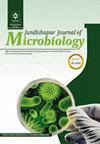Detection of the SARS-CoV-2 Genome in Peripheral Blood Mononuclear Cells of Hospitalized Patients With COVID-19 Infection
IF 0.5
4区 医学
Q4 MICROBIOLOGY
引用次数: 0
Abstract
Background: Evaluation of viral pathogenicity is an important part of research in every viral disease, and one of the most important parts of pathogenicity is cell and tissue tropism of viruses, which can help us to have a clear picture of the viral replication cycle and viral disease. Objectives: This study aims to evaluate the possibility of SARS-CoV-2 replication in peripheral blood mononuclear cells (PBMCs) of hospitalized patients with COVID-19. Methods: Twenty-six whole blood samples (5 mL) were collected from 70 hospitalized patients infected with SARS-CoV-2. Plasma and PBMCs were collected and subjected to total RNA extraction using the alcohol-chloroform precipitation method by the RNX solution. After complementary DNA (cDNA) synthesis, all samples were subjected to real-time and nested polymerase chain reactions (PCRs) to detect the viral genome. Results: The nested PCR method showed a higher rate of positivity in plasma samples (42.3%) compared to real-time PCR (30.7%), suggesting nested PCR exhibited better sensitivity. This rate in PBMC samples was 57.7% by nested PCR and 7.7% by real-time PCR. Minus-strand viral genome was detected in PBMCs, demonstrating that these cells can support virus replication and act as a virus transporter through blood. Conclusions: PBMCs can be infected with SARS-CoV-2. Plasma and serum samples are also not useful samples for virus detection because all of the positive plasma samples in this study showed low viral load with a low cycle threshold (Ct) value.新冠肺炎感染住院患者外周血单核细胞中SARS-CoV-2基因组的检测
背景:病毒致病性的评估是每种病毒疾病研究的重要组成部分,而致病性最重要的部分之一是病毒的细胞和组织嗜性,这可以帮助我们清楚地了解病毒复制周期和病毒疾病。目的:本研究旨在评估新冠肺炎住院患者外周血单核细胞(PBMC)中SARS-CoV-2复制的可能性。方法:收集70例严重急性呼吸系统综合征冠状病毒2型住院患者的26份全血样本(5 mL)。收集血浆和PBMC,并通过RNX溶液使用醇-氯仿沉淀法进行总RNA提取。在互补DNA(cDNA)合成后,对所有样本进行实时和嵌套聚合酶链反应(PCR)以检测病毒基因组。结果:与实时PCR(30.7%)相比,嵌套PCR方法在血浆样本中的阳性率(42.3%)更高,表明嵌套PCR具有更好的敏感性。用套式PCR法和实时PCR法检测PBMC的阳性率分别为57.7%和7.7%。在PBMC中检测到负链病毒基因组,表明这些细胞可以支持病毒复制,并作为病毒通过血液的转运蛋白。结论:PBMC可感染严重急性呼吸系统综合征冠状病毒2型。血浆和血清样本也不是用于病毒检测的有用样本,因为本研究中所有阳性血浆样本都显示出低病毒载量和低循环阈值(Ct)值。
本文章由计算机程序翻译,如有差异,请以英文原文为准。
求助全文
约1分钟内获得全文
求助全文
来源期刊

Jundishapur Journal of Microbiology
MICROBIOLOGY-
CiteScore
1.30
自引率
0.00%
发文量
56
审稿时长
6-12 weeks
期刊介绍:
Jundishapur Journal of Microbiology, (JJM) is the official scientific Monthly publication of Ahvaz Jundishapur University of Medical Sciences. JJM is dedicated to the publication of manuscripts on topics concerning all aspects of microbiology. The topics include medical, veterinary and environmental microbiology, molecular investigations and infectious diseases. Aspects of immunology and epidemiology of infectious diseases are also considered.
 求助内容:
求助内容: 应助结果提醒方式:
应助结果提醒方式:


